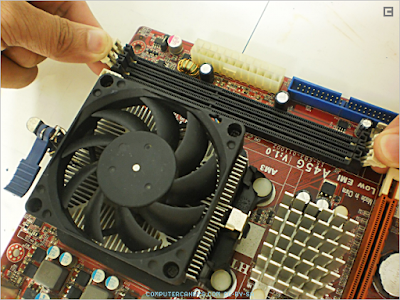HOW TO INSTALL MEMORY
|
|
Install into Memory slot. Memory modules are extremely sensitive to static charges and should be handled very carefully. Never touch the metal conductors, and only handle RAM modules by their edges. When handling memory, hold it by each end of the module and be careful not to bend it, flex it or drop it while handling it.
|
|
Check Memory Modules
Before actually installing the RAM modules in your computer, check again to make sure that the RAM you have is of the correct type and speed for your motherboard. Most computers nowadays use DDR- II DDR-III or DDR-IV memory modules, but double-check to make sure.
Proper Insertion of the RAM Modules
Examine the memory module before installing it into the computer. Make sure that the notches match up with the memory slot you are installing the memory into. These notches allow the memory to only be installed in one direction and if it is not a compatible memory will not match up at all.
How to Install Memory
01 • Prepare and check your memory before installation
02 • In your motherboard, locate the memory expansion slot
03 • Open the RAM retaining clips in order for RAM to be installed
04 • First memory, match the notch in the RAM module to the grove in the slot
05 • Hold down the first memory and slide in the module and push down on the two ends
06 • Second memory, match the notch in the RAM module to the grove in the slot
07 • Hold down the second memory and slide in the module and push down on the two ends
08 • Now were done with memory installation
After verifying the notches and direction the memory needs to be installed move each memory slot tab out or away from the memory module. These tabs will snap into place as the memory module is installed.
Once these tabs have been moved out, push memory module firmly, straight down into the slot, and push the retainer clips inward, the two tabs should snap and hold the memory module into place. That's it.
NOTE: If there are more notches than there are tabs, then you have the wrong RAM for your motherboard. Same thing goes for if the notches and tabs don't match up. You have the wrong RAM, and all the force in the world won't make it the right RAM.
Manufacturers and Speeds
In theory, it shouldn't matter if the RAM modules installed in a computer are made by different manufacturers, as long as the type and speed are the same. There are standards for this sort of things, so memory from different manufacturers should be compatible. But sometimes subtle differences between manufacturers can cause problems; so I recommend that you purchase RAM made by the same manufacturer, if possible.
Also in theory, when different speed RAM modules are used, all of the RAM should clock to the speed of the slowest module. But in reality, I've found that mixing RAM speeds sometimes causes system instability. I've had plenty of cases where RAM sticks that tested just fine alone wouldn't play well together. So I strongly recommend that all of the RAM installed in your computer be of the same speed. In fact, in practice, I just use all identical sticks in any given computer. Whenever possible, I'll even remove perfectly good RAM when doing an upgrade, just so all the sticks I install are identical.
Warning
When pushing the memory into the computer do not apply an excessive amount of pressure, doing this could cause damage to the memory module as well as the slots on the motherboard.







